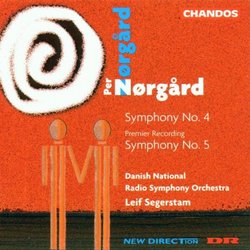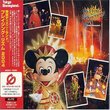| All Artists: Per Norgard, Leif Segerstam, Danmarks Radiosymfoniorkester Title: Per NÝrgard: Symphonies Nos. 4 & 5 Members Wishing: 1 Total Copies: 0 Label: Chandos Release Date: 5/20/1997 Genre: Classical Styles: Historical Periods, Modern, 20th, & 21st Century, Symphonies Number of Discs: 1 SwapaCD Credits: 1 UPC: 095115953327 |
Search - Per Norgard, Leif Segerstam, Danmarks Radiosymfoniorkester :: Per NÝrgard: Symphonies Nos. 4 & 5
 | Per Norgard, Leif Segerstam, Danmarks Radiosymfoniorkester Per NÝrgard: Symphonies Nos. 4 & 5 Genre: Classical
|
Larger Image |
CD DetailsSimilar CDs |
CD ReviewsMore Amazing Norgard 08/03/2000 (5 out of 5 stars) "Here is a continuation of Chandos's marvellous series of Norgard symphonies with this orchestra and conductor. In the Fourth and Fifth symphonies, the composer ventures into new territory entirely. Although the immense range of colours and textures are familiar from the Third symphony, they are put to entirely new purposes; where the Third was single-minded and monumental, these are far more turbulent, fragmented and expressionistic. Much of the music seems to be operating in inaudible, parallel universes - there are places in the Fifth symphony, for instance, where the sounds become higher and higher in pitch until they literally vanish into the stratosphere, to appear a little later at the very bottom of the orchestra - as if the pitch spectrum were a circular, not linear at all (!). All of this goes together with a new fascination with 'unmusical' sounds like bird calls, flexatone, and unpitched sounds on conventional instruments, sounds that speak rather than singing. The playing of the Danish National RSO and the beautifully detailed sound capture every detail of Norgard's strange and highly original symphonic world." Schizophrenic Fourth, Enigmatic Fifth Christopher Forbes | Brooklyn,, NY | 03/18/2003 (4 out of 5 stars) "I've held off reviewing these two symphonies from my Norgard cache until now...mostly because after several listenings they still elude me a bit. While I found the 1st and 2nd symphonies immediately appealing...the 6th quite haunting and the 3rd overwhelming, I am somewhat of a loss on these two, particularly the 5th. After more than a dozen listenings, here is the best I can do for review.The Norgard 4th has grown on me...it took alot of time, but it has grown. The symphony was the product of Norgard's fascination with the schizophrenic artist, poet and composer Adolf Wolfli. Wolfli was committed to an asylum early in his life and spent the remainder of his days creating a world in which he voyaged, quite literally. A search on the artist reveals almost mandala like artistic designs, maps for his inner worlds. Wolfli left sketches for a music book in his papers after he died. The musical notation has never been deciphered, but Norgard used it as a springboard for his symphony. The work is in two movements (by now typical for Norgard) It begins with another typical Norgard gesture...the descending scale passage. Soon the first movement - the Rose Garden - begins to take shape. It is dominated by a short motif based on fourths. This motif, which is based on a bird call, is introduced by a solo violin and expanded both texturally and harmonically...blurring into what Norgard calls tone lakes. The movement is mostly light, not tonal, but light, but it is streaked with darker and more dissonant moments. By contrast, the second movement - Chinese Witch's Lake - is violent and dark, but relieved by moments of brightness recalling the first movement. As you listen and gain familiariety with the work, it becomes deeper and deeper. It ends up having almost Jungian overtones.I wish I could say that the 5th symphony has won me over as well, but I can't. The work is enigmatic to say the least. While the orchestration reveals Norgard as one of the great colorists of the 20th century, the material is difficult. This is Norgard at his most "modern". The language is harsh and dissonant, which for me is not necessarily a condemnation. But it also is fragmented and disjointed, something that you cannot say about other Norgard works. It doesn't have the organic unity that makes the 2nd and 3rd such attractive works and keeps even the more modernist 6th together. I may change my opinion of the work over time, but right now it is my least favorite of the Norgard symphonies. So, yes, these are symphonies worth hearing, and perhaps worth owning, as one listening will not reveal everything they have to offer. But they are not the best introduction to the composer. For that, I recommend the 3rd symphony. That is the composer's masterpiece." A haunting "Wolfli-period" work along with the composer's mo Christopher Culver | 07/18/2006 (4 out of 5 stars) "This Chandos disc contains performances of the fourth and fifth symphonies by contemporary Danish composer Per Norgard, performed by the Danish National Radio Symphony Orchestra conducted by Leif Segerstam. "Symphony No. 4" is one of Norgard's most accessible works, eerie though it is, while "Symphony No. 5" is undoubtedly the most enigmatic of his myriad works to date.
"Symphony No. 4: Indian Rose Garden and Chinese Witch's Lake" (1981) is based on the art of Adolf Wolfli, a madman locked up in a Bern asylum from 1896 who produced hundreds of remarkable drawings in a superbly original style. Norgard's embarking on a Wolfli-inspired period in 1979 is seen as such a profound break from his writing up to that point that in order to really put the Fourth in perspective one first has to understand what came before. In the 1970s Norgard's music was based on the "infinity series", a method of serializing melody that created fractal-like self-similarity between all instrumental lines. I'll take the the second movement of his "Voyage into the Golden Screen" as an example: Norgard writes the entirety with the infinity series: a given melody is played by the flutes in what can be called "normal time", while the oboes play every fourth note, the trumpets every 64th note, and tubular bells, trombones, and piano ever 256th note. As a result, the very same music can be heard at many different speeds depending on which orchestral group one concentrates on, and if one listens to the music as a whole one hears a blissful succession of notes that is predictable enough to be easily accessible yet contains many surprises. The unity of all elements also presented a strong spiritual feeling for this metaphysically-inclined composer. In "Symphony No. 4", the writing has changed in a slight way that has profound consequences: there is repetition of elements, and several little motifs are heard again and again, a good reflection of the psychotic art Norgard took as a model. However, the repetition is limited to one plane, there is no overarching, slower form. With this breaking of the unity of the whole, Norgard has gone from cosmic oneness to fearful isolation, loneliness, torment, and despair. In terms of sound, the warm, fuzzy cloud of the infinity series gives way to cold, crystalline blocks of sound. The first movement, "Indian Rose Garden" is slow and meditative, and marked by a motif based on the call of the European robin which gives rise to other motifs, hides, and then appears again in full. Among the idyllic forest of orchestration, there is an unmistakable howl of pain here and there. "Chinese Witch's Lake", the second movement, breaks in violently without a pause, and is an expression of rage and catastrophe. The falling apart of the natural order is symbolised by the incoherent mixing of quotations from popular melodies, Nielsen, and other Norgard works. The Fourth is powerful stuff, and contains an wealth of new ideas to explore with each listening. The orgiastic Third is often considered Norgard's finest symphony, and justly so, but I find this hommage to the tortured soul of Wolfli to be thought-provoking and poignant enough to merit more attention that it is has received. The "Symphony No. 5" (1986-1990, rev. 1992) is already somewhat infamous among Norgard fans. The listener at once notices that it presents brand-new concepts which up until that point had not preoccupied the composer, such as large orchestral arpeggios, tone lakes, and massive orchestral movements that bring the sound up so high it seems to dissipate like smoke. Interference tones are exploited as well, as when one of the percussionists blows through a pair of dog-whistles, producing a tone that would be inaudible on its own. There's also a significant use of quotation, for the symphony refers to the composer's third and first symphonies, and at one point the popular tune "Jingle Bells" shows up. However, while Norgard is certainly looking back here, there's no real synthesis of all his various techniques to date. Such a fusion he succeeded in making in the sixth symphony. So the listener is immediately dazzled by the technical inventiveness and striking colour of the piece, but on hearing the form as a whole bafflement sets in. What exactly is he doing here? A common venture is that this is a symphony about writing a symphony. It consists of a series of bold musical propositions that leap out, only to collapse into shocking silences as if they form a musical dead-end. All in all, I'm left scratching my head. I like this piece, it sounds wonderful, but I just don't get it at all. The fifth certainly should be the last symphony the Norgard fan encounters, as it assumes prior knowledge of the "Sinfonia Austera" and the Symphony No. 3, which latter work is his masterpiece and makes for an ideal introduction to the composer. Still, both the 4th and the 5th are interesting pieces, and collecting all of Norgard's symphonies are highly recommended." |

 Track Listings (6) - Disc #1
Track Listings (6) - Disc #1
